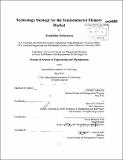| dc.contributor.advisor | James M. Utterback. | en_US |
| dc.contributor.author | Nakamura, Tomohiko | en_US |
| dc.contributor.other | System Design and Management Program. | en_US |
| dc.date.accessioned | 2013-01-23T19:45:56Z | |
| dc.date.available | 2013-01-23T19:45:56Z | |
| dc.date.copyright | 2012 | en_US |
| dc.date.issued | 2012 | en_US |
| dc.identifier.uri | http://hdl.handle.net/1721.1/76504 | |
| dc.description | Thesis (S.M. in Engineering and Management)--Massachusetts Institute of Technology, Engineering Systems Division, System Design and Management Program, 2012. | en_US |
| dc.description | Cataloged from PDF version of thesis. | en_US |
| dc.description | Includes bibliographical references (p. 74-75). | en_US |
| dc.description.abstract | Solid state memories are used in a variety of applications as data and code storages. A non-volatile memory is a memory that retains information when its power supply is off. Flash memory is a type of nonvolatile memory that can be erased and programmed by data called blocks. Flash memory is used to store system control codes in various applications. A recent representative example is Solid State Drive (SSD). A SSD is a type of computer storage that is composed of a number of flash memories. SSDs store data electronically unlike hard disk drives, which store data magnetically. The advantages of a solid-state drive are: no mechanical parts, less power and weight than hard disk drives. This thesis investigates existing technologies, markets, emerging technologies, and applications in the solid state memory market. It analyzes the current solid state memory industry structure using market data and frameworks. The emerging technologies and applications are researched in order to deliver technological innovations to the semiconductor memory market. It also studies and suggests how strategies of firms might influence technologies, value chains, and future evolutions using system dynamics models. The system dynamics models are based on a conventional commodity market model because of similarity between the semiconductor memory market and the commodity market. The simulation results provide insights into future market evolutions caused by new technologies. This research will lead to recommendations for companies currently struggling to survive in the industry, and for companies considering entry. | en_US |
| dc.description.statementofresponsibility | by Tomohiko Nakamura. | en_US |
| dc.format.extent | 75 p. | en_US |
| dc.language.iso | eng | en_US |
| dc.publisher | Massachusetts Institute of Technology | en_US |
| dc.rights | M.I.T. theses are protected by
copyright. They may be viewed from this source for any purpose, but
reproduction or distribution in any format is prohibited without written
permission. See provided URL for inquiries about permission. | en_US |
| dc.rights.uri | http://dspace.mit.edu/handle/1721.1/7582 | en_US |
| dc.subject | Engineering Systems Division. | en_US |
| dc.subject | System Design and Management Program. | en_US |
| dc.title | Technology strategy for the semiconductor memory market | en_US |
| dc.title.alternative | Technology strategy in highly competitive market | en_US |
| dc.type | Thesis | en_US |
| dc.description.degree | S.M.in Engineering and Management | en_US |
| dc.contributor.department | System Design and Management Program. | en_US |
| dc.contributor.department | Massachusetts Institute of Technology. Engineering Systems Division | |
| dc.identifier.oclc | 823517428 | en_US |
